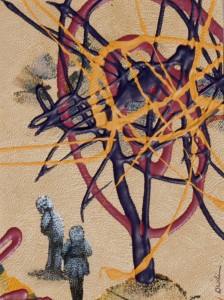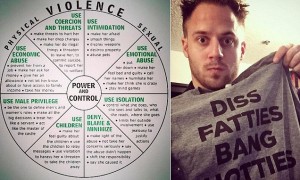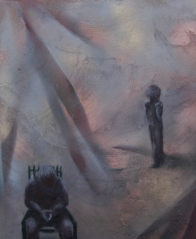March27
  Beware overcaring for it can promote Dependent Personality Disorder (DPD) in a disabled child and they can self injure, self endanger, self deprive to compulsively monopolise the carer out of an pathologically exaggerated belief in their their own incapacity and vulnerability. DPD co-occurs in children who have had Separation Anxiety Disorder and Avoidant Personality Disorder. However, the compulsion of those with DPD to control the carer through progressive helplessness/loss of skills is, by far the most disabling of the three commonly co-occurring conditions. There are solutions to turning around co-occurring Dependent Personality Disorder in children deemed ‘Severely Autistic’ and where it is turned around the child will still be autistic but generally not nearly as ‘Severely Autistic’ as their Dependent Personality Disorder was presenting them to be. Â
 Beware overcaring for it can promote Dependent Personality Disorder (DPD) in a disabled child and they can self injure, self endanger, self deprive to compulsively monopolise the carer out of an pathologically exaggerated belief in their their own incapacity and vulnerability. DPD co-occurs in children who have had Separation Anxiety Disorder and Avoidant Personality Disorder. However, the compulsion of those with DPD to control the carer through progressive helplessness/loss of skills is, by far the most disabling of the three commonly co-occurring conditions. There are solutions to turning around co-occurring Dependent Personality Disorder in children deemed ‘Severely Autistic’ and where it is turned around the child will still be autistic but generally not nearly as ‘Severely Autistic’ as their Dependent Personality Disorder was presenting them to be. Â
Read the rest of this entry »
March20
 Â NARCOLEPSY
 NARCOLEPSY
Speak not of the luxury of choice
of the choice to indulge
to decide, to rest, to sleep
for I can only dream of such things
once again devoured by invisible clouds
of sedation uninvited
like the eye of a hurricane
pulled down through the pillow
into REM sleep in the blink of an eye
sleep’s addictive call
its inarguable claim
of body, of mind
stealing wakefulness
stealing time
stealing luxury of choice
with one cast of its wand
in the clutching grip
of a hand called narcolepsy
Read the rest of this entry »
February26
 When we think about autism related developmental, behavioural and learning challenges we usually think about sensory perceptual disorders, sensory integration issues or hypersensitivities, about gut, immune or metabolic disorders, dyspraxia, speech and communication disorders or mood, anxiety or compulsive disorders. But personality and identity may figure equally as much for particular people in determining their reaction to their autism.
When we think about autism related developmental, behavioural and learning challenges we usually think about sensory perceptual disorders, sensory integration issues or hypersensitivities, about gut, immune or metabolic disorders, dyspraxia, speech and communication disorders or mood, anxiety or compulsive disorders. But personality and identity may figure equally as much for particular people in determining their reaction to their autism.
We all have around 4-6 of Oldham’s 16 recognised personality traits – Ptypes.Â
Each of these come with their own unique motivation and distress patterns meaning that different personalities will respond very differently in how they adapt to an ongoing sources of challenge, frustration, isolation or trauma.
Certain conditions can hone or inhibit particular personality traits, pushing these into the range for Personality Disorders. Read the rest of this entry »
February8
 Though there is no actual evidence Jesus ever existed anthropologists have constructed what he’d have looked like from the stories of his proposed place and time of birth. Essentially, he’d have looked much like some of the Palestinians today. Read the rest of this entry »
Though there is no actual evidence Jesus ever existed anthropologists have constructed what he’d have looked like from the stories of his proposed place and time of birth. Essentially, he’d have looked much like some of the Palestinians today. Read the rest of this entry »
February8
 Â Religion makes some people feel better, stronger, some feel too weak, lost, helpless without someone with superpowers having the ultimate control, a safety net Read the rest of this entry »
 Religion makes some people feel better, stronger, some feel too weak, lost, helpless without someone with superpowers having the ultimate control, a safety net Read the rest of this entry »
February8
  The Dandenong Ranges is home to so much iconic Indigenous plants and animals and so it attracted masses of tourists every year to its national parks, to Puffing Billy, and other iconic tourist magnets. But what if you are a tourist or visitor from overseas, wanting to experience Indigenous Australian culture up here in the Dandenongs? Read the rest of this entry »
 The Dandenong Ranges is home to so much iconic Indigenous plants and animals and so it attracted masses of tourists every year to its national parks, to Puffing Billy, and other iconic tourist magnets. But what if you are a tourist or visitor from overseas, wanting to experience Indigenous Australian culture up here in the Dandenongs? Read the rest of this entry »
February7
 The government knows the facts yet continues to lie to the public because fear and hatred keeps people loyal to the party.Â
The government knows the facts yet continues to lie to the public because fear and hatred keeps people loyal to the party. 
Read the rest of this entry »
January19
We pick up objects… things… taking power, taking ownership of things. It requires no emotional intelligence. In fact the less emotional intelligence you have the less it will get in the way… things like empathy, dignity, equality. Like any psychopath, any sociopath, any narcissist, a pick up artist needs only to know how to feign such things. But let’s at least get it straight, if you are going to be a paying tool for the likes of Julien Blanc

and Jeff Allen Read the rest of this entry »
January2
 What ways are you autistic?
What ways are you autistic?
My autism effected my functioning on these 14 levels: Read the rest of this entry »
December15
 Why, if you you wish to love and be loved
Why, if you you wish to love and be loved
do you invest all your spare time in objects? Read the rest of this entry »
  Beware overcaring for it can promote Dependent Personality Disorder (DPD) in a disabled child and they can self injure, self endanger, self deprive to compulsively monopolise the carer out of an pathologically exaggerated belief in their their own incapacity and vulnerability. DPD co-occurs in children who have had Separation Anxiety Disorder and Avoidant Personality Disorder. However, the compulsion of those with DPD to control the carer through progressive helplessness/loss of skills is, by far the most disabling of the three commonly co-occurring conditions. There are solutions to turning around co-occurring Dependent Personality Disorder in children deemed ‘Severely Autistic’ and where it is turned around the child will still be autistic but generally not nearly as ‘Severely Autistic’ as their Dependent Personality Disorder was presenting them to be. Â
 Beware overcaring for it can promote Dependent Personality Disorder (DPD) in a disabled child and they can self injure, self endanger, self deprive to compulsively monopolise the carer out of an pathologically exaggerated belief in their their own incapacity and vulnerability. DPD co-occurs in children who have had Separation Anxiety Disorder and Avoidant Personality Disorder. However, the compulsion of those with DPD to control the carer through progressive helplessness/loss of skills is, by far the most disabling of the three commonly co-occurring conditions. There are solutions to turning around co-occurring Dependent Personality Disorder in children deemed ‘Severely Autistic’ and where it is turned around the child will still be autistic but generally not nearly as ‘Severely Autistic’ as their Dependent Personality Disorder was presenting them to be.    NARCOLEPSY
 NARCOLEPSY
 Though there is
Though there is  Â Religion makes some people feel better, stronger, some feel too weak, lost, helpless without someone with superpowers having the ultimate control, a safety net
 Religion makes some people feel better, stronger, some feel too weak, lost, helpless without someone with superpowers having the ultimate control, a safety net   The Dandenong Ranges is home to so much iconic Indigenous plants and animals and so it attracted masses of tourists every year to its
 The Dandenong Ranges is home to so much iconic Indigenous plants and animals and so it attracted masses of tourists every year to its  The government knows the facts yet continues to lie to the public because fear and hatred keeps people loyal to the party.Â
The government knows the facts yet continues to lie to the public because fear and hatred keeps people loyal to the party. 

 What ways are you autistic?
What ways are you autistic?
